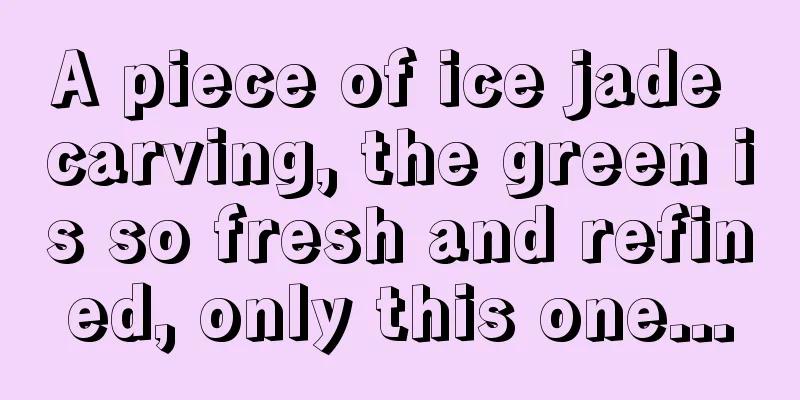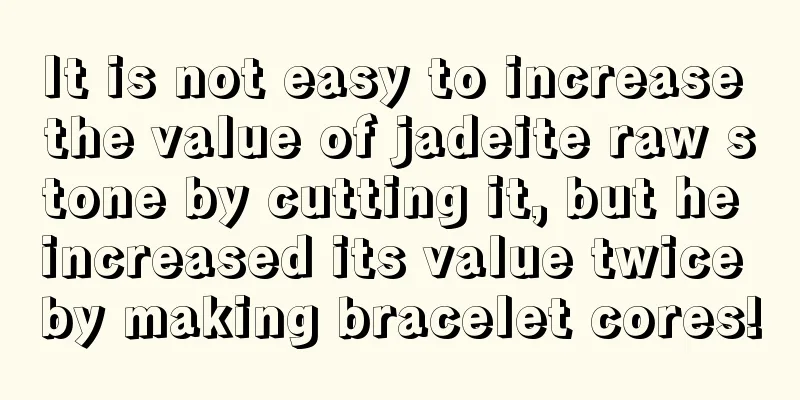There are too many dyed jades on the market. How can we easily identify them?

|
With the decrease in the output of jadeite raw stones, the price of jadeite has risen again. It is precisely because of this situation that the jadeite market is in chaos, and the phenomenon of counterfeits and inferior products has become more serious. So how can we quickly and easily identify them? Currently, many jades on the market are made of strong acid injection and dyeing. Low-grade jade is transformed into high-grade jade after processing. Next, I, Lao Wang, will talk to you about how to identify dyed jadeite! First of all, why does jade need to be “dyed”? Through artificial dyeing methods, the color of colorless or light-colored jade can be turned into green, red or purple to imitate jade of better quality. This type of jade is called C-grade jade. Secondly, what do they use to dye? There are many kinds of dyes used for dyeing, such as amino dyes, chromates, and common purple and green polishing powders on the market, which can be used directly as dyes to dye the surface of jade. Finally, how do we identify dyed jadeite? 1. Observe with the naked eye that the color is exaggerated, the contrast is large, it is not correct and unnatural. Color roots are a color generation phenomenon. The color is in the form of strips, flakes, and lumps, with a gradient in depth. It diffuses from the inside to the outside or gradually penetrates into the interior of the jadeite. Color root is one of the identification bases for judging whether a jade piece is jadeite, or whether jadeite is artificially colored. However, for high-end jadeite of the old pit variety, its color roots are invisible or difficult to see because of its fine structure and uniform color. 2. When checking under magnification, for cases where the color is uneven and looks very similar to the real thing, pay attention to the phenomenon of color on color, that is, the mixing of real and fake colors. The key in this case is to find the difference in hue and other aspects between the real and fake colors at the edges where the colors overlap. 3. Observe under an incandescent lamp with a Charpy filter. If the color appears red, it means it is artificially colored. If the color does not turn red, there are two possibilities: natural color or dyeing, which requires further identification using other methods. 4. You can use ultraviolet fluorescent lamp to observe. Natural purple jadeite generally has no fluorescent reaction under ultraviolet light, while dyed purple jadeite often has more obvious fluorescence under ultraviolet light. Generally, colorless quartzite is dyed, and the dyed quartzite looks realistic and natural, and is difficult to detect. This type of dyed quartzite has a fine texture, high transparency, and bright color, and is often used to resemble high-end jadeite. So please be careful when buying again!
fruit fcgc33 |
<<: How to identify A, B, and C grade jadeite?
>>: Buying jadeite is not a loss if you compare more
Recommend
Of the nine jade carving awards, if you can win three or more, you are not far from becoming a master!
Let’s take a look at the nine most prestigious ja...
There are many colors of jade, and different colors of jade are suitable for people with different personalities.
As we all know, jade is colorful. Although it doe...
Is tri-color jade the same as tri-color jade?
Are three-color jade and three-color jade the sam...
How many steps does a sculptor need to go through in the process of turning a piece of rough stone into a finished jadeite product?
Jade cannot be made into a useful object without ...
The simplest and quickest method to identify A-grade jadeite is all here!
Players all know that only A-grade jade has colle...
The ingenious carvings always bring us different surprises
In the jade world, the most amazing work is carvi...
About the distinction and identification of jadeite ABCD goods
Usually we see finished jadeite for sale in the m...
Jade is the best gift, but do you know how to give jade as a gift?
Jade has a variety of patterns and is deeply love...
When appreciating jadeite, experts look at the quality while laymen look at the color? How to avoid pitfalls when purchasing jadeite?
The appreciation of jadeite is divided into two a...
Guess why women are obsessed with jade? The last one is the most heartfelt——
There is no doubt that Women are the most loyal f...
Jade artistic conception, understanding is the charm
In the eyes of jade designers, every piece of jad...
Characteristics of Jade Carving Technology
Friends around me often comment on jade carvings ...
What is “C-grade” jade? How to identify?
C-grade jadeite refers to jadeite that has been a...
Teach you how to identify the authenticity of jadeite!
Jade is a type of jade. Because of its fine and m...
This is how the color of emerald comes from
Jade has a very wide variety of colors. There are...









